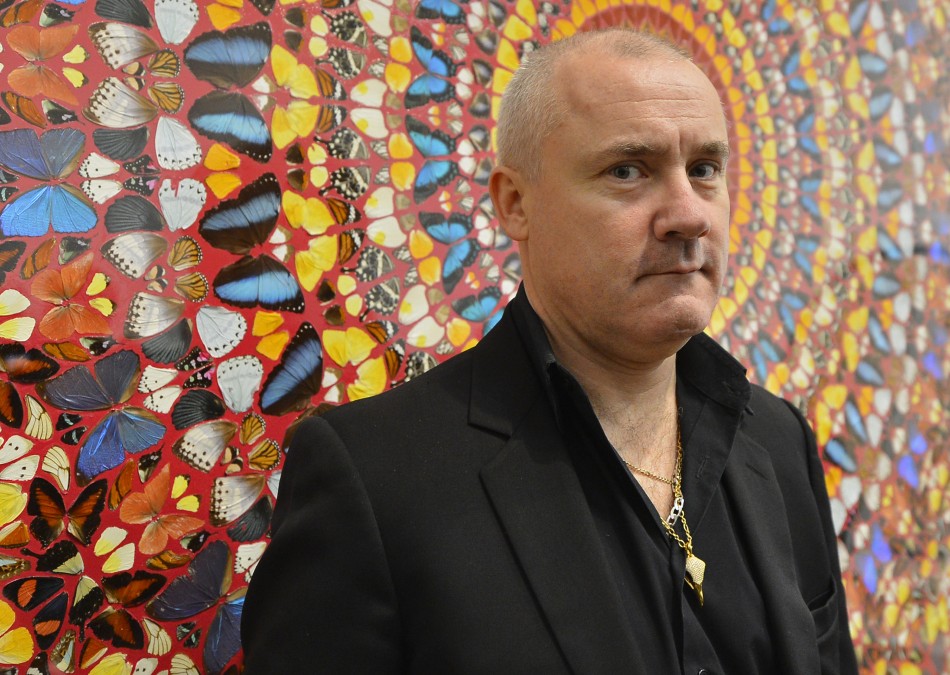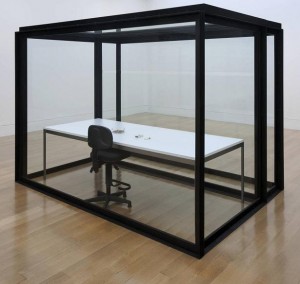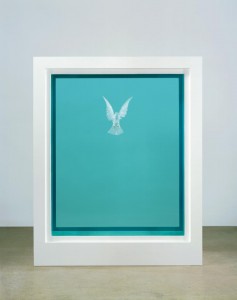Review: Damien Hirst (Tate Modern) Arts & Culture
Arts & Culture, Exhibition, New in Ceasefire - Posted on Wednesday, April 18, 2012 0:00 - 7 Comments

Tate Modern’s Damien Hirst exhibition claims to be the first major survey of his work held in London. It is not. It is, however, the first major survey of his archetypal pieces. Spread over fourteen impressive rooms, it charts the artist’s work from his undergraduate days in the eighties through to the Sotheby auction of 2008 (cannily cutting off before the poorly received paintings of 2009).
 The first room, containing the early work, is colourful, fun, fresh and, in retrospect, very charming. Hirstian themes that will recur throughout the exhibition are introduced; namely death and mortality, spots, clever titles and, via the block sculpture Boxes, the compartmentalising of things. The centrepiece is a baby-pink pedestal, on which is placed a retro hairdryer undertaking the Sisyphean task of keeping a golf ball afloat. It is aptly and wittily called What Goes Up Must Come Down. Balanced against a wall, in a casual manner that recalls initial student warehouse exhibitions, is Hirst’s first eponymous spot painting.
The first room, containing the early work, is colourful, fun, fresh and, in retrospect, very charming. Hirstian themes that will recur throughout the exhibition are introduced; namely death and mortality, spots, clever titles and, via the block sculpture Boxes, the compartmentalising of things. The centrepiece is a baby-pink pedestal, on which is placed a retro hairdryer undertaking the Sisyphean task of keeping a golf ball afloat. It is aptly and wittily called What Goes Up Must Come Down. Balanced against a wall, in a casual manner that recalls initial student warehouse exhibitions, is Hirst’s first eponymous spot painting.
This spot painting is exciting for two reasons. Firstly, Hirst probably made it himself. Considering the criticism he has received for having assistants paint all of the later series (bar five), there is something quite touching about imagining a young Hirst bothering to create it. Secondly, it is flawed. The paint runs and drips, colour blends into colour and spot into spot. The canvasses of the later series, with each spot perfectly rounded off and set in its own exact space, look as though they were mechanically produced in a factory in Chengdu Province to be sold in the kids’ bedroom department of Ikea. They become tiresome; it feels as though every time curator Ann Gallagher didn’t know what to do with a wall, she was able to fall back on one of the 1400 available.
The life and death cycles, A Thousand Years and the two-room installation In and Out of Love, are so fantastic that they alone are an argument for conceptual art. In the former, flies are born, feed luxuriantly on a cow’s head and then either live to breed, or die on the insect-o-cutor hung wickedly close to the meat. In the latter, butterflies pupate on white canvasses, organically creating an artwork, then flutter by joyfully in a paradise of humidity, pot plants and tropical fruit. Both pieces are hypnotic and thought-provoking. One is delightful, the other disturbing; the repulsively sweet smell of the rotting cow hovers around a ventilation shaft in the vitrine. If nothing else, Hirst is a God among insects.
Another interesting vitrine is The Acquired Inability to Escape. Within the glass box sit an office chair and desk. On the desk is a full ashtray, a Silk Cut packet and a lighter. The installation is ‘useful’ in an anti-Aesthete way as it provides something to look at while queueing to get into In and Out of Love. Unintentionally, it gives a sense of the passing of time as the Silk Cut packet is presented in all its glory without a health warning. Never such innocence again. An Acquired Inability to Escape is one of many cigarette pieces in the exhibition, and these will presumably become evermore politicised as anti-smoking sentiment increases, their role in Hirst’s mortality obsession evermore apparent as cigarettes become a definitive symbol of death.
[jj-ngg-jquery-slider gallery=”22″ html_id=”Trayvon-2″ width=”550″ height=”400″ center=”1″ effect=”fade” pausetime=”6000″]
Hirst is a self-referential artist. Flies, butterflies, pills, cabinets, fag ends: all these things reappear throughout the exhibition. But there is a thin line between creating a conversation within the narrative of your work and just appearing to be stuck for ideas; or repeating the same ones because you know they sell. Loving in a World of Desire constitutes a brightly coloured beach ball floating up and down above a huge air blower. An echo of What Goes Up Must Come Down, it is bigger, brasher, with a less amusing title: a piece created by an artist with far more money to spend on materials. Ultimately, it is boring. Gallagher, whose curation is sensitive and intelligent, appears to have recognised this and has put it aside in a small room with three pieces from the equally uninteresting spin painting series. Similarly, Crematorium, a gigantic ashtray filled with cigarette butts and packets, does nothing more than labour the point of the inevitability of death, but in a less subtle way.
Money and the market are Hirst’s inspiration and playground. A room in the later part of the exhibition stands testament to this. A spot painting is made out in gold, jewels glitter from the cabinets on the walls. Even the wallpaper itself is a reflection on cash: Gallagher has chosen metallic, golden holograms. The centrepiece is Kingdom, another formaldehyde shark but one without the direct shock and scale of The Physical Impossibility of Death in the Mind of Someone Living. It seems a piece designed for someone who couldn’t afford the original.
Judgement Day recalls the pill cabinets of Lullaby, The Seasons, each diamond set in its own glass box. Of course both diamonds and pills can be symbols of decadence, but while the original is a clever comment on the years passing towards inevitable death, Judgement Day cannot really be valued beyond the fact that it is a Hirst and probably has something to do with mortality and money. One will stand the test of time, the other, almost certainly, will not. ‘Ooo, this is the pretty room,’ says a girl on entering. That is perhaps the critical commentary it deserves, and perhaps the one Hirst would most appreciate.
 Hirst loves to pre-empt his critics. He is quoted as saying, ‘I can’t wait to make really bad art and get away with it’, making any accusation on those lines futile. If he has made ‘bad art’ he has certainly gotten away with it. Now, however, his pieces are sharply declining in value and the naysayers are starting to outshout his supporters. The age of Hirst, for the time being, may be passing.
Hirst loves to pre-empt his critics. He is quoted as saying, ‘I can’t wait to make really bad art and get away with it’, making any accusation on those lines futile. If he has made ‘bad art’ he has certainly gotten away with it. Now, however, his pieces are sharply declining in value and the naysayers are starting to outshout his supporters. The age of Hirst, for the time being, may be passing.
This makes the final exhibit (Gallagher’s most brilliant stroke) immensely touching. Remembrance is a spot painting, but one all in white with a touch of gold leaf to bring out the spots, a ghost, and indeed memory, of its ancestors. It is hidden behind the beautiful The Incomplete Truth, a formaldehyde white dove in mid-flight. One could almost walk past it, many probably have. But for those who note it, and note the title, it is a final Hirstian quip on the passing of things, and an appropriate conclusion to a fun and important exhibition.
Damien Hirst
Tate Modern: Exhibition
4 April – 9 September 2012
[£14, concessions available]
7 Comments
ANNA DI SCALA
Klaus Bubblehammer
Hirst is a con-artist, who has been made a billionare by sponsors like the Saatchi circle and the culure-hacks with an interest in the ‘art market’. He claims he spends the cash he flaudulently amasses selling his tack on buying palaces for himself, a la Simon Cowell, his closest rival. At the last count he’d aquired 30 of them.
He ran out of ideas soon after leaving Leeds Art School, having permanently put the wind up himself skipping classes to hang around public mortuaries sketching dead bodies. This explains all you need to know about Damian Hirst.
happysmiles
“We are motivated by a belief in the free exchange of radical and ground-breaking ideas”
Since when has welfare for the rich been either?!
spurnlad
Hirst is a symptom of the disease known as The Emperors New Clothes. Eventually, the up-their-own-arse art establishment will realise they have been conned and it wil be ‘Well, who’d have thought it?’ They will then be stuck with a pile of worthless junk they have [paid milions for: BRING IT ON!!!
occupytatemodern
Yes, bring it on, spurnlad.
The final room is actually the merchandise room where you can buy a set of plates or wallpaper for thousands of pounds.
Daniel Barnes
It is refreshing to see a largely positive review. The show is spectacular in all the right and wrong ways. I would like to note, however, that Damien selected all the work himself and the proliferation of spot paintings was entirely his choice, not the curator’s. Moreover, since forever – ie 1991 – Damien has always put spot paintings on the wall behind Natural History works, such as A Thousand Years and The Physical Impossibility… It is part of his duality between the frivolous and the terror.
[…] https://ceasefiremagazine.co.uk/damien-hirst-tate-modern/ – an interesting little review of the exhibition. […]



bravo Damien Hirst born under a star discala